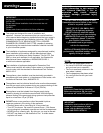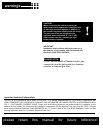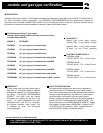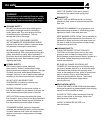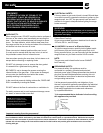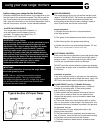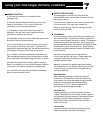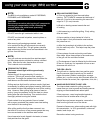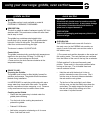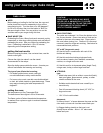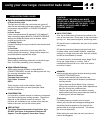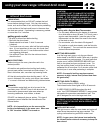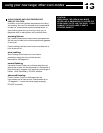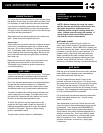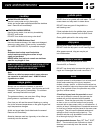
8
using your new range: BBQ section
NOTE:
The BBQ is only available on model # PSGR364B,
PSGR486B, and PSGR486BG.
CAUTION!
Use extreme care when placing the grill components
into the grill compartment. Avoid contacting the
ceramic igniter that could break, preventing
operation of the grill.
DO NOT leave the grill unattended while in use.
DO NOT use charcoal briquettes, ceramic plates, or
coals of any kind.
After removing all packaging materials, check
to be certain that the grill components are correctly
assembled in the grill box. The grill grates, stainless
steel radiant tray and the burner are assembled in the
grill box from the factory.
NOTE:
Your grill racks are constructed from stainless steel
and have been electro-polished to achieve a brilliant
finish. After the first use, discoloration will occur.
This is natural and unavoidable
COOKING ON THE BBQ:
The burner should light within approximately
5 seconds.
Preheat the grill for approximately 10 minutes
minimum. The hot grill sears the food, sealing in
the juices. The longer the preheat time, the faster the
meat browns and the darker the brand marks.
Grilling requires high heat for optimum results. High heat
is necessary for searing and proper browning. Most foods
are cooked at higher heat settings for most of the cooking
time. However, when grilling large pieces of meat or
poultry, it may be necessary to turn the heat to a lower
setting after the initial browning. This cooks the food
thoroughly without burning the outside.
Foods cooked for a long period of time or basted
with a sugary marinade may need a lower heat setting
near the end of the cooking time.
After grilling and the food has been removed, turn
the knob to HI and burn off any excess grease that may
have accumulated on the stainless steel radiant.
Use a brass wire brush, dipped in hot water, to loosen
food particles from the grate.
GRILLING SUGGESTIONS:
a) Trim any excess fat from the meat before
cooking. FATTY MEATS increase the likelihood of
flare-ups. Cut slits in the remaining fat around the
edges at 2” (51 mm) intervals.
b) Brush on basting sauces towards the end
of cooking.
c) Add seasoning or salt after grilling. Early salting
dries out meat.
d) Use a spatula or tongs instead of a fork to
turn the meat. A fork punctures the meat and lets
the juices flow out.
e) After the juices begin to bubble to the surface,
turn the meat only once. This helps keep the juices
in the meat.
f) Some pieces of meat and poultry cook faster
than others. Move those pieces to the cooler area
of the grill until the rest have finished.
g) The doneness of meat is affected by the thickness
of the cut. Chefs say it is impossible to have a rare
doneness with a thin cut.
THE GRILL RACK:
The grill rack is a double sided, two position grate.
Use the concave side (channels up) for meats of
higher fat content (Steaks, hamburgers, sausage
patties, etc.); use the convex side (channels down) for
foods of lesser fat content (fish, vegetables, fruits, etc.)
HANDLING EXCESSIVE FLARE- UPS:
The intense heat needed for grilling may also
cause flare-ups, due to grease and basting sauces
dripping on the stainless steel radiant plate.
If flare-ups occur, use a long handled spatula to
move the food to another area of the grill.
Should flare-ups become excessive, remove the
food from the grill and turn off the burner.
Excessive flames occur when cooking meat with high
fat concentration, i.e. 30% ground beef, untrimmed
steaks, lamb chops, etc.
Be cautious when turning meat over.



